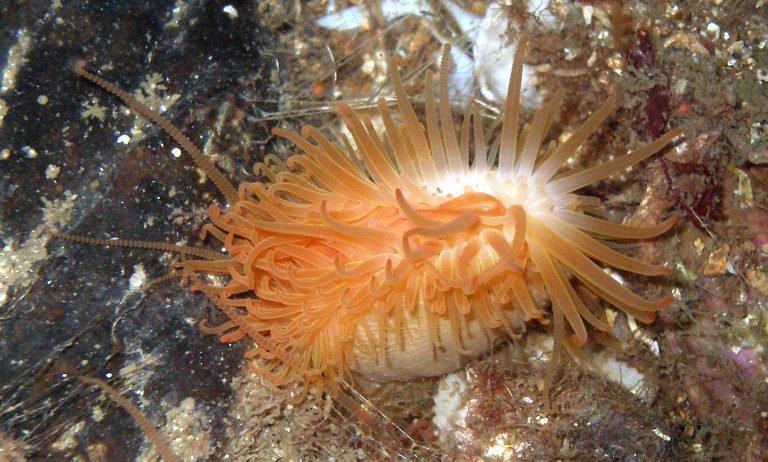
Flame shell. Credit: COAST
Scotland’s coastline and inshore waters support a wealth of marine species and ecosystems, much of it vital to local livelihoods, but all too often its coastal communities have not been given a voice in how their seas are managed.
Fauna & Flora International (FFI) works closely with coastal communities and local NGOs to support their efforts to ensure a better future for Scotland’s inshore waters. One of the most active of our Scottish partners is COAST (the Community of Arran Seabed Trust), recognised as a global pioneer in community-led conservation after establishing the first and only community-managed no-take zone in UK waters.
With world leaders preparing to gather at COP26 in Glasgow – just 50 miles from Arran as the gannet flies – we asked Jenny Crockett, Outreach & Communications Manager at COAST, to give us an insight into her community’s hopes, fears and expectations as this crucial climate conference unfolds on her doorstep.
What was the rationale for establishing COAST?
COAST was established in the face of catastrophic collapses in the Clyde sea fisheries, damage to seabed habitats and loss of marine life that were witnessed directly by the local Arran community. These ecosystem-wide impacts in the Clyde occurred as a result of the failure of fisheries management to address overfishing, and the opening up of all coastal waters to towed bottom fishing gear in 1984 when the three-mile inshore fisheries limit was repealed.
COAST was founded by two local Arran divers who worked with the local community to successfully campaign for protection of areas of sea around their island. Their sustained efforts over many years resulted in the establishment of the Lamlash Bay No Take Zone (NTZ) in 2008 and, following this, the designation (2014) and subsequent legal protection from mobile bottom fishing (2016) of a larger area of nearly 300 km2 as the South Arran Marine Protected Area (MPA).
How has it benefited the island community?
As a community-led organisation, COAST has championed the rights of local people to have their voices heard in decision-making about their local seas, including fisheries management.
The success of grassroots activism on Arran has led to a sense of ownership of the protected areas, and locals feel empowered to help protect them. For example, we have a number of MPA compliance spotters, who have met with Marine Scotland Compliance to challenge the inadequate levels of protection afforded to our MPAs in Scotland.
Other benefits have included a boost to ecotourism, particularly those activities based on, in or by the sea, and local walking and wildlife guides understand the connection between healthy, abundant seas and vibrant and clean coastlines.
The success of the NTZ and MPA has generated significant press interest, helping to boost the local economy and bringing wider recognition for the effectiveness of grassroots marine conservation. COAST has won a series of awards, including the Nature of Scotland Award 2014, Goldman Environmental Prize 2015, Spirit of the Community Environment Winner 2017. Just this year, it was recognised as one of the top 20 ‘Outstanding Examples’ of the United Nations 100+ Positive Practices for Biodiversity around the World.
What differences have you noticed since the no-take zone was established?
Collaborative research is showing how proper protection of seabed habitats from bottom-towed fishing gear supports the recovery of marine biodiversity, ecosystem function and populations of commercially important species.
For example, king scallops within the NTZ have increased significantly both in size and density (almost fourfold) since protection was put in place. Densities are now increasing outside the NTZ, in the MPA, where scallop diving is allowed, with a greater than sixfold increase since scallop dredging was prohibited in 2016.
Data from 2018 showed numbers of legal-sized European lobster are over four times higher in the NTZ than in adjacent areas. Lobsters in the NTZ are also larger and produce 135% more eggs than seen outside a protected area. Local fishermen are witnessing a ‘spillover’ effect, leading to higher catches of lobster and scallop outside the protected area.
In the NTZ, total cover of both plants and animals growing on the seabed is approximately twice that in areas still open to scallop dredging. In the South Arran MPA the total density of marine life has more than doubled.
Read more Listen to local voices – A message from Scotland’s coastal communities at Fauna & Flora International.
Tags: Climate change, COAST, Community, Management